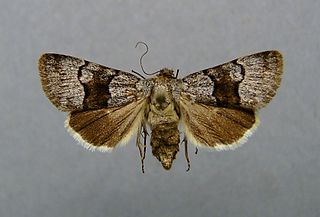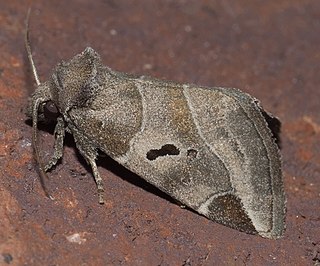
Acontiinae is a subfamily of bird dropping moths in the family Noctuidae. There are more than 50 genera and 430 described species in Acontiinae, found worldwide in temperate and tropical climates.

Amphipyrinae is a subfamily of owlet moths in the family Noctuidae. There are more than 50 genera and 210 described species in Amphipyrinae, although the classifications are likely to change over time.

Apantesis is a genus of tiger moths in the family Erebidae first described by Francis Walker in 1855. They are found in North and Central America.
Chlorobaptella is a monotypic moth genus of the family Crambidae erected by Eugene G. Munroe in 1995. Its only species, Chlorobaptella rufistrigalis, was first described by William Barnes and James Halliday McDunnough in 1914. It is found in North America, where it has been recorded from California and Nevada. Moths in this genus are distinguished from moths in similar genera by their small palpi and obsolete tongues.
Chrismania is a monotypic moth genus of the family Crambidae. Its only species, Chrismania pictipennalis, is found in North America, where it has been recorded from southern California and Arizona. Both the genus and species were first described by William Barnes and James Halliday McDunnough in 1914.

Donacaula is a genus of moths of the family Crambidae. The genus was erected by Edward Meyrick in 1890.

Basilodes is a genus of owlet moths in the family Noctuidae. There are about six described species in Basilodes.

Chalcopasta is a genus of owlet moths in the family Noctuidae. There are about nine described species in Chalcopasta.

Cryphia is a genus of moths of the family Noctuidae. The genus was erected by Jacob Hübner in 1818.

Eulithosia is a genus of moths of the family Noctuidae erected by Henry Edwards in 1884.

Oxycnemis is a genus of moths of the family Noctuidae. The genus was erected by Augustus Radcliffe Grote in 1882.

Sympistis is a genus of moths of the family Noctuidae. The genus was erected by Jacob Hübner in 1823.

Stiriinae is a subfamily of owlet moths in the family Noctuidae. There are more than 20 genera and 130 described species in Stiriinae.
Negalasa is a monotypic snout moth genus. Its one species, Negalasa fumalis, is found in the US state of Arizona. Both the genus and species were described by William Barnes and James Halliday McDunnough in 1913 in the same paper.
Mattesia is a genus of parasitic alveolates of the phylum Apicomplexa. Species in this genus infect insects.

Stiriini is a tribe of owlet moths in the family Noctuidae. There are about 16 genera and more than 90 described species in Stiriini.
Chrysoecia gladiola is a species of moth in the family Noctuidae. It was first described by William Barnes in 1907 and it is found in North America.
Chrysoecia thoracica is a species of moth in the family Noctuidae.

Tallula is a genus of pyralid moths in the family Pyralidae. There are about 11 described species in Tallula.
William David Barnes was an American entomologist and surgeon. He was the son of Dr. William A. and Eleanor Sawyer Barnes. He graduated salutatorian from the Decatur High School in 1877. Then spent a year at Illinois State University followed by a year at University of Illinois at Urbana–Champaign. In 1879, he entered Harvard Medical School and graduated in 1886. While at Harvard, he met naturalist Louis Agassiz and his love of Lepidoptera grew. Agassiz taught him how to preserve and classify the butterflies. He completed an internship at Boston City Hospital and then studied abroad in Heidelberg, Munich, and Vienna. In 1890, Dr. Barnes came home to Decatur and opened his medical practice. That same year he married Charlotte L. Gillette. The couple had two children: William Barnes Jr., and Joan Dean Gillett Barnes.











